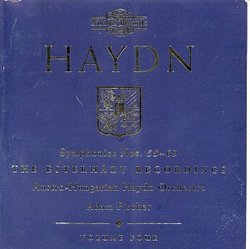| All Artists: Franz Joseph Haydn, Adam Fischer, Austro-Hungarian Haydn Orchestra Title: Haydn: Symphonies 55-69 Volume Four Members Wishing: 0 Total Copies: 0 Label: Nimbus Records Release Date: 4/20/1999 Album Type: Box set Genre: Classical Styles: Historical Periods, Classical (c.1770-1830), Symphonies Number of Discs: 5 SwapaCD Credits: 5 UPC: 710357559020 |
Search - Franz Joseph Haydn, Adam Fischer, Austro-Hungarian Haydn Orchestra :: Haydn: Symphonies 55-69 Volume Four
 | Franz Joseph Haydn, Adam Fischer, Austro-Hungarian Haydn Orchestra Haydn: Symphonies 55-69 Volume Four Genre: Classical
|
Larger Image |
CD Details |
CD ReviewsExploring the Haydn Symphonies -- Nos. 62,64,65 and More Robin Friedman | Washington, D.C. United States | 08/02/2006 (5 out of 5 stars) "Adam Fischer and the Austrio-Hungarian Haydn Orchestra have accomplished the daunting task of recording the complete Haydn symphonies. They share this accomplishment with Antal Dorati and the Philharmonica Hungarica and with a less familiar earlier cycle with Ernst Mazendorfer conducting the Vienna State Opera (for the Musical Heritage Society.) The Fisher recordings were made at Esterhaza using modern instruments but historic performance practices. The harpsichord continuo is not used. Fischer's Haydn cycle is available on eight multi-CD sets on Nimbus.
This 5-CD collection includes 15 Haydn symphonies, nos. 55 -- 69 which generally date from 1772 -- 1781. A small number of these symphonies may date from Haydn's so-called "sturm und drang" period, but most are later. During the time Haydn composed these works, he was preoccupied with composing opera. Thus, much of the material in these works is in the style of operatic overture, or of comic opera. In addition Haydn borrowed freely from other compositions or projects in composing these symphonies as his main compositional activity at the time was elsewhere. But these works still reflect the knowledge and skills Haydn had gained in writing for the orchestra. He was a composer who learned and grew continuously. This set includes some relatively familiar works, beautifully played. As usual these works tend to have nicknames, such as the "Schoolmaster" symphony no. 55, or the "Fire" symphony, no. 59, or " La Roxelane" no. 63. But I want to concentrate in this review on three symphonies, two of which are rarities, for reasons which I will explain at the conclusion. Symphony no. 64 in A major bears the nickname "Tempora mutantur" which may be Haydn's. The opening "allegro con spirito" has some piquant, sharp harmonies, unsusual for Haydn's time. The work opens with a quiet opening phrase, followed by a theatrical, lively main theme. The highlight of this work, as in much of Haydn, lies in the slow movement which bears the unusual, for him, marking of Largo. This is a broad, slow and detailed movement with much interplay between horn and strings. There is a stormy outburst in mid-movement which recalls the sturm und drang character of Haydn's earlier minor key symphonies. The minuet is short in light, in contrast to the two earlier movements with passages for horn and solo violin in the trio. The concluding presto alternates a quiet opening passage with a loud dramatic theme and, as does the Largo, features a lengthy and highly dramatic episode in the minor key. Symphonies 62 and 65 are rarities, seldom recorded or performed. Yet they contain much fresh and worthwhile music. Symphony no. 62 in D major borrows material in its opening movement from the finale of its predecessor, the Symphony no. 53 in D major, L'Imperial. It opens with a lound flashy series of chords followed by a lyrical theme. The symphony also features a quirky allegretto which is based upon what appears to be a three-note accompaniment figure bounced back and forth among the instruments. Only in the brief coda does a melodic figure appear to join the accompaniment. The bright and lively theme of the minuet is taken by the strings with a wind choir in the trio. The final allegro again alternates a quiet opening passage with a lively theme. It includes a minor-key interlude and a big fanfare at the close. Symphony no. 65 in A major is also rarely heard. The first movement is in the style of an opera overture, with a dramatic, bright opening theme contrasting with a lovely lyrical second theme. Unusually, the opening chords return in the recapitulation only in a much subdued form. The slow movement is one of Haydn's most unusual. It involves a waving, sinuous theme in the violins punctuated by the horns. It is an odd, wayward movement which Haydn scholar H.Robbins Landon has described as of "almost lunatic irrationality." The minuet features the use of an odd grace note in some measures, making the rhythm seem to shift from 3/4 to 4/4. The final presto is in the form of a call and response movement as passages for the horn alternate repeatedly with answers in the strings. With the reviews of symphonies 62,64, and 65, I have completed a survey of Haydn's 104 numbered symphonies on this site using various conductors, orchestras, and labels. I have enjoyed getting to know this great body of music in some detail. I hope these reviews will encourage their readers to explore the symphonies of Haydn. Robin Friedman" |

 Track Listings (12) - Disc #1
Track Listings (12) - Disc #1